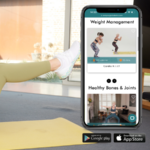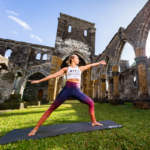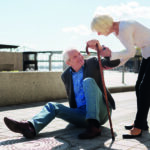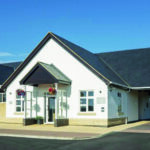Want an activity that can help you get fit, save money and do your bit for the environment? Get on your bike! as Michelle Higgs explains
“Cycling has huge benefits for your health – but only if you do it regularly. One way to ensure that cycling doesn’t become a passing fad is to add it to your normal routine”
“It can take a while to build up fitness levels and stamina to be able to do long bike rides, so steadily increase the distance you cycle over several weeks, rather than rushing into it”
“Go into any bike shop and you’ll discover a myriad of different types of bike. You need to choose the right one for you and your needs, specifically the type of cycling you’ll be doing”
“The more you ride, the more confident and skilled you will be and the fitter you will become”
Facts/stats
In England, 15% of adults and children (aged 5 and over) cycle more than once a week
(NTS Survey, 2021)
47% of adults and children (aged 5 and over) in England own or have access to a cycle
(Cycling UK)
In England, 27% of people who cycle regularly do so to commute to work or school.
(NTS Survey, 2021)
As a physical activity, cycling has so many incredible benefits for your health and wellbeing. It’s an excellent way to build up to the 150 minutes of physical activity per week, recommended by the NHS. It’s also an environmentally-friendly form of transport so you’ll automatically reduce your carbon footprint. Even better, cycling outdoors means you’ll be spending more time in nature. Being in the great outdoors is known to improve your mood and help you cope better with stress. What’s not to like?
By now, you’re probably keen to get on your bike, but wait! If you haven’t cycled for many years, you should start off in a quiet traffic-free area such as your local park or a dedicated cycle path. Get used to mounting and dismounting your bike again, and to applying the brakes and gears. It can take a while to build up fitness levels and stamina to be able to do long bike rides, so steadily increase the distance you cycle over several weeks, rather than rushing into it.
Get the right bike
Go into any bike shop and you’ll discover a myriad of different types of bike. You need to choose the right one for you and your needs, specifically the type of cycling you’ll be doing. Decide whether you’re most interested in cycling off-road, on the road, or a mixture of the two. If you’re not sure, a hybrid bike is probably best. The bike shop staff will be happy to advise on this.
Remember, you don’t need to spend lots of money to get a decent bike. And there’s no point in buying a top-of-the-range model if you’re not sure yet whether cycling’s for you. Another alternative is to hire a bike for a short period to get a feel for cycling.
It’s even possible to get a good second-hand bike, but if you do go down this route, take it to the bike shop for a service to make sure it’s in good enough condition to ride safely. The same applies if you’re dusting off your old bike from the shed.
Take some cycling lessons
They say you never forget how to ride a bike, but that’s only half true. If it’s been many years since you cycled, it’s likely you’ll have lost the confidence you once had. Before attempting to go anywhere near a main road on a bike, find out if there are any refresher lessons for adults in your area. This will reintroduce you to cycling in a safe way. You’ll be part of a small group led by an instructor who will guide you in re-learning cycling skills, boosting your confidence and fitness levels over a number of weeks.
Cycle regularly
Cycling has huge benefits for your health – but only if you do it regularly. One way to ensure that cycling doesn’t become a passing fad is to add it to your normal routine. Think about whether you can do some of your usual short car journeys by bike instead. These short trips help to boost your activity levels. The more you ride, the more confident and skilled you will be and the fitter you will become.
If possible, aim towards cycling to work so that you’re combining two things in one – the commute and aerobic exercise. If that’s not feasible, why not commit to a weekend ride or in the evenings during the summer months? You may also enjoy the ride more without the pressure of having to get to your destination by a particular time.
Commute by bike
Imagine being able to save money on petrol while getting to work. You can if you leave the car at home and cycle the commute instead – it’s more environmentally-friendly too! It’s worth considering if you’re confident riding in traffic, or there’s a route that only follows cycle lanes and cycle paths. Check the maps to plan the best route, and work out if you’re fit enough to cover the distance there and back. Part of the journey may need to be done by train, but make sure that trains on that particular route allow bikes on board. Commuting by bike works best if your employer is supportive of cycling. There needs to be a safe place to leave your bike during the day, and there should be a shower you can use so that you don’t start work all hot and sweaty.
Look after your bike
Just like a car, your bike needs regular maintenance to ensure it runs as well as it should. If you’ve never had a bike before, it’s well worth looking at online videos to find out how to look after your bike and keep it in tiptop condition. The charity Cycling UK has lots of videos and how-to guides about maintenance of bikes and all aspects of cycling on its website (www.cyclinguk.org).
At the very least, you should know how to fix a puncture and how to replace an inner tube in the tyre. Take a repair kit with you on every ride – it should include a pump, a puncture repair kit, an inner tube and tyre levers.
6 tips for beginners
- Start small
Don’t try to cycle too much, too soon. Start with short local journeys, preferably on quiet lanes or canal towpaths. Then you can venture out onto the roads for longer distances.
- Ride confidently
When cycling on roads, it’s important that you’re visible to other traffic. That’s why it’s recommended that you ride assertively at least 1 metre from the kerb; this also means other vehicles won’t be tempted to try squeezing past.
- Know the Highway Code
Under the rules for cyclists, you must not ride on the pavement. At night, you must have white front and red rear lights lit; your bike must also be fitted with a red rear reflector and amber pedal reflectors.
- Get equipped
Comfortable layered clothing is best – you don’t need Lycra! A properly fitting cycle helmet is essential, and if you’re riding to work, you’ll probably need panniers or another type of bag.
- Plan your routes
Cycling should be fun so plan your routes to avoid heavy traffic wherever possible. Choose canal towpaths, riverside cycle paths, trails through public and country parks – anywhere away from the hustle and bustle where you can benefit from nature.
- Get the whole family involved
Cycling is a great activity that all the family can enjoy. Take the opportunity to show your kids how much fun cycling is and why it’s so much better for the environment. Plan days out on your bikes and get fit as a family – cycling is a wonderful way to spend quality time together.














![BODi-NPA_UK-MPU_Hero-1300×450[14]](https://www.yourhealthyourpharmacy.co.uk/wp-content/uploads/2023/09/BODi-NPA_UK-MPU_Hero-1300x45014-1-150x150.jpg)

























































































![19150_Diageo NCP MPU Hero_1300x450px[94][42]](https://www.yourhealthyourpharmacy.co.uk/wp-content/uploads/2023/04/19150_Diageo-NCP-MPU-Hero_1300x450px9442-150x150.png)














